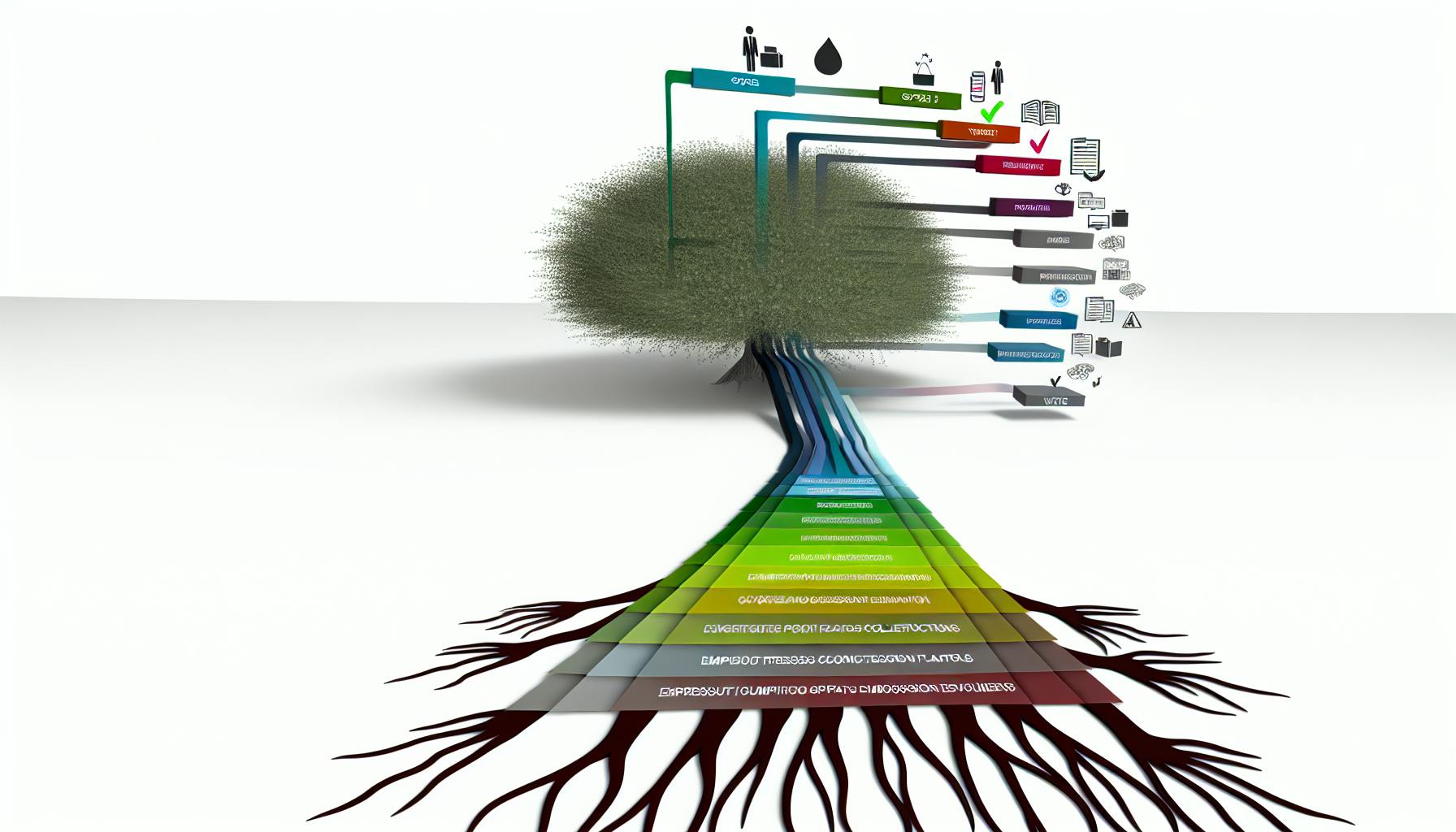With greenhouse gas emissions being a growing concern, small and medium enterprises (SMEs) may struggle with understanding compliance requirements and how to achieve emissions reductions.
Luckily, new SaaS solutions are emerging to help SMEs easily track, report, and reduce their greenhouse gas emissions in alignment with regional and global policies.
In this article, we'll overview key emissions regulations, outline capabilities to look for in tracking software, and detail implementation best practices to leverage these tools for greater sustainability.
Greenhouse Emissions and SME Compliance
Greenhouse gas (GHG) emissions reporting and compliance requirements are complex issues, especially for small and medium-sized enterprises (SMEs) with limited resources. However, with the right tools and guidance, SMEs can navigate these technicalities efficiently.
Defining Key Terms
Let's clarify some key terminology first:
- Greenhouse gases (GHGs): Gases such as carbon dioxide and methane that trap heat in the atmosphere, contributing to climate change.
- Emissions: The release of GHGs into the atmosphere from sources like transportation, electricity use, and industrial processes.
- Compliance: Adhering to emissions monitoring, reporting, and reduction regulations mandated by governments and other governing bodies.
Business Case for Emissions Reductions
Measuring and reducing emissions aligns with cost savings, efficiency gains, stakeholder pressures, and long-term business resilience for SMEs. Benefits include:
- Operational cost savings from energy efficiency and resource optimisation
- Tax incentives and other financial benefits for lowering emissions
- Stakeholder satisfaction by showcasing sustainability commitment
- Future-proofing against tightening regulations and climate impacts
Emissions accounting software can simplify compliance, quantify savings potential, and engage stakeholders for SMEs pursuing sustainability.
What is greenhouse emission?
Greenhouse gas emissions refer to the release of gases such as carbon dioxide, methane, nitrous oxide, and fluorinated gases into the atmosphere. These gases trap heat in the atmosphere, causing the greenhouse effect that leads to global warming.
The main human activities that produce greenhouse gas emissions are:
- Burning fossil fuels like coal, oil, and natural gas for electricity, heat, and transportation
- Industrial processes and product use
- Agriculture, forestry, and land use changes
- Waste management
Measuring a company's greenhouse gas emissions allows them to identify the largest sources, set reduction targets, and track progress over time. There are guidelines like the Greenhouse Gas Protocol that enable standardised emissions calculations and reporting.
For small and medium enterprises (SMEs), calculating emissions can be complicated. That's where software solutions like EcoHedge come in. They automate the quantification process, ensuring consistency, accuracy, and compliance with the latest regulations. This allows SMEs to efficiently report their emissions and engage stakeholders on their environmental initiatives.
What is the emission of greenhouse?
Human emissions of greenhouse gases like carbon dioxide, methane, and nitrous oxide are driving climate change. These gases are released when we burn fossil fuels for energy, manufacture materials like steel and cement, and even grow food.
As small and medium enterprises (SMEs) conduct business, their operations also lead to greenhouse gas emissions that contribute to climate change. To understand their impact, SMEs need to measure and report their greenhouse gas emissions across business activities. This process is known as greenhouse gas accounting and reporting.
Some key things for SMEs to know:
- Major sources of emissions include energy use, transportation, waste generation, and agriculture or land use changes. The more energy from fossil fuels used, the more CO2 released.
- Reporting emissions involves calculating your carbon footprint using methodologies like the Greenhouse Gas Protocol. This considers all scopes of emissions - direct, indirect from energy use, and other indirect.
- With data on greenhouse emissions, SMEs can identify hotspots to reduce environmental footprint. This brings strategic and reputational benefits with stakeholders.
- Monitoring and reporting emissions is becoming a compliance issue. Regulations like CSRD in the EU will enforce mandatory climate-related disclosures.
By starting early to track and report emissions with carbon accounting software, SMEs can get ahead of rising stakeholder expectations and compliance risks. The role of SaaS solutions is to simplify this complex process.
What are the main causes of greenhouse emissions?
The main causes of greenhouse emissions stem from human activity that releases excessive amounts of carbon dioxide (CO2) and other heat-trapping gases into the atmosphere. The three primary contributors are:
Burning Fossil Fuels
The burning of coal, natural gas, and oil for electricity, heat, and transportation is the leading cause of global greenhouse gas emissions. This releases large quantities of carbon dioxide that amplifies the greenhouse effect and drives climate change.
Switching to renewable energy sources like solar, wind, and hydropower can significantly reduce emissions from this major source. Energy efficiency improvements in buildings, transportation, and industry can also limit fuel combustion.
Deforestation
Forests act as carbon sinks, absorbing CO2 from the atmosphere. Rampant deforestation, especially destruction of rainforests, releases stored carbon back into the air while also reducing nature's capacity to remove emissions.
Sustainable forestry practices and forest protection policies are critical to conserve these carbon reservoirs and ecosystems. Reforestation and afforestation projects further help with carbon sequestration.
Intensive Agriculture
Agriculture generates considerable methane and nitrous oxide emissions from activities like fertilizer application and livestock digestion processes.
Using precision farming techniques, low/no-till methods, and breeding lower methane cattle can potentially lower emissions from this sector.
What is the main source of greenhouse emissions?
Most of the anthropogenic greenhouse emissions in the United States come primarily from the burning of fossil fuels like coal, natural gas, and petroleum for energy use. Transportation and electricity generation account for a large share of these fossil fuel emissions.
Other major sources include:
- Agriculture and farming activities
- Industrial processes like cement and steel production
- Waste management including landfills and wastewater
According to the EPA, the top greenhouse emissions by source in 2019 were:
- Transportation (29% of 2019 emissions)
- Electricity production (25%)
- Industry (23%)
- Commercial and residential (13%)
- Agriculture (10%)
The largest driver remains the continued reliance on fossil fuels across sectors of the economy. Shifting to renewable energy sources and enhancing efficiency measures can significantly cut greenhouse emissions over time. SMEs have an important role to play through improving their own operations and engaging stakeholders.
sbb-itb-919600f
Greenhouse Gas Emissions by Source: Identifying SME Impacts
This section will break down the sources of greenhouse gas emissions and how they relate specifically to SME operations.
Emissions Scopes and Boundaries
We'll define emissions scopes 1, 2, and 3, providing sector-specific examples of emission sources to include.
- Scope 1 emissions come directly from sources owned or controlled by the company. This includes fuel combustion, company vehicles, and industrial processes. For an SME, this may be natural gas used to heat buildings, diesel used in delivery trucks, or HFC refrigerants from AC units.
- Scope 2 covers indirect emissions from purchased electricity used in the company's owned or controlled equipment. For SMEs, this is typically purchased electricity used to power offices, warehouses, stores, plants, etc.
- Scope 3 emissions are all other indirect emissions from the company's value chain. Examples include purchased goods/services, business travel, waste disposal, etc. For an SME, Scope 3 emissions like employee commuting and waste can be a large contributor.
It's important to map all emissions sources from your operations and establish an inventory boundary based on the level of influence your company has over each activity. Tools like EcoHedge Express can help SMEs easily collect and categorise emissions data across Scopes 1-3.
Collecting Primary Data
Here we discuss best practices for gathering granular, facility-level emissions data across your operations.
- Track fuel, electricity, and other consumption data at each facility or operation under your control. Many SMEs have 5-10 key sites contributing the bulk of emissions.
- Install smart metering equipment to automatically collect granular energy usage data over time. This allows for benchmarking and efficiency tracking.
- Conduct periodic equipment audits and maintenance checks to identify energy waste - this often reveals simple fixes like HVAC leaks.
- Implement a data collection process across departments (facilities, procurement, HR, finance, etc) to compile a complete view of usage.
- Utilise SaaS tools like EcoHedge Lifecycle to automatically pull primary data from utility bills, fleet telemetry systems, travel booking platforms, etc. to minimise manual data entry.
Leveraging Secondary Data Sources
For emissions factors and other reference data, we recommend these publicly available data sources.
- Use EPA emissions factors for fuels, electricity region/state, and other sources when primary usage data is available. Factors convert activity data into CO2e.
- Consult industry-specific carbon accounting guidance from GHG Protocol, SBTi and others based on your sector.
- Check for local and regional factors suited to your operations - for example state-level electricity emissions rates.
- Use lifecycle analysis data from think tanks like the Carbon Trust to estimate emissions from materials, transport modes, recycling, etc.
- Tools like EcoHedge Express contain updated emissions factors from leading public sources, taking the manual work out of factor research.
Efficiency Opportunities by Source
We highlight high-impact energy efficiency initiatives tailored to top SME emission sources like buildings, transport, manufacturing processes, and more.
- Buildings: LED lighting retrofits, smart building controls, HVAC upgrades, improved insulation, and onsite renewables.
- Transport: Route optimisation, clean vehicles, anti-idling policies, biofuels, and employee commuting programs.
- Manufacturing: Equipment upgrades, waste heat recovery, process optimisation, and material efficiency.
- Supply Chain: Supplier engagement, low carbon procurement, circular materials, and product life extensions.
Using granular data and optimisation tools, EcoHedge identifies your largest current emissions sources and sizes potential reduction opportunities, allowing you to prioritise high-ROI efficiency projects with stakeholder support.
Comparing Greenhouse Emissions by Country: SMEs on the Global Stage
Greenhouse gas emissions vary significantly across countries and regions, presenting unique compliance challenges for small and medium sized enterprises (SMEs) operating internationally. As climate change regulations tighten globally, understanding emissions by geography helps SMEs strategise reductions and maintain legal compliance.
Regional, National, and Subnational Policies
- North America features a patchwork of climate policies, with aggressive goals in some states and provinces but limited federal regulations in the US and Canada. SMEs must track different protocols and reporting requirements at multiple government levels.
- Europe has more uniform regional climate policies under the EU Emissions Trading System (ETS), a
greenhouse emissionscap and trade program covering key industrial emitters. However, individual countries implement additional national regulations that SMEs must follow. - Asia has emerging nationwide carbon pricing programs and emissions trading systems in South Korea, Japan, and China. These policies focus more on large emitters but SMEs in targeted sectors must begin measuring their greenhouse gas output.
Industry-Specific Regulations
Beyond geographic regulations, SMEs in certain sectors face emissions rules and standards. Examples include:
- Manufacturing SMEs must account for energy and process emissions in carbon taxes and ETS programs. Sustainability reporting requirements also target carbon footprints.
- Transportation SMEs face clean vehicle standards, fuel efficiency rules for fleets, and future bans on internal combustion engine vehicles in some regions.
- Building SME owners must improve energy efficiency to comply with strict performance standards for new and existing real estate in Europe, North American cities, and Australia.
Navigating International Compliance
With varied climate policies across borders, SMEs operating internationally can simplify compliance by:
- Centralising emissions tracking and reporting with cloud-based software like EcoHedge that handles different protocols and standards.
- Partnering with local consultants and legal counsel to ensure adherence to regulations in each country of operation.
- Setting company-wide emissions reductions goals that satisfy the most stringent regulations in any geography.
- Communicating sustainability initiatives clearly to stakeholders worldwide through automated stakeholder engagement tools.
Though daunting, an international SME can thrive in a low carbon future by streamlining compliance digitally while letting local teams adapt reduction strategies to regional climate policy landscapes.
Using SaaS Tools to Track and Report Emissions
This section explores how purpose-built SaaS solutions can eliminate the manual effort of emissions data collection, calculations, and reporting for SMEs.
Key Capabilities to Look For
When evaluating SaaS solutions for greenhouse gas emissions management, SMEs should look for a few key capabilities:
- Automated data collection and calculations: The software should seamlessly pull emissions data from various sources, including utility bills, fleet fuel purchases, business travel, and more. It should automatically calculate emissions according to established methodologies like the Greenhouse Gas Protocol. This eliminates manual data entry and complex calculations.
- Customisable reporting: The solution should flexibly generate emissions reports tailored to different stakeholders like investors, customers, and regulators. This ensures compliance with various disclosure programs and frameworks.
- Data visualisation: Interactive charts and graphs provide visibility into emissions sources and trends over time. This helps SMEs make informed, data-driven decisions on reduction strategies.
- Stakeholder engagement tools: Capabilities to create customised sustainability reports for external audiences allow SMEs to showcase progress and build brand value.
Implementation Best Practices
When rolling out an emissions tracking SaaS platform, SMEs should:
- Get executive buy-in: Educate leadership on sustainability risks and secure commitment for emissions reduction targets. This facilitates organisation-wide adoption.
- Start with largest sources: Identify facilities, operations, and supply chain elements representing the highest emissions contributions. Prioritise integrating these into the system first.
- Automate data connections: Leverage built-in integrations with various data sources like utility accounts, travel agencies, etc. to automatically pull in emissions data. This eliminates manual efforts over time.
- Train key users: Ensure employees submitting data inputs and maintaining the system understand the platform and methodology. This encourages compliance and data quality.
With the right solution and effective implementation, SMEs can transform emissions tracking from a manual chore to an automated, insightful process. Purpose-built SaaS tools are key to unlocking sustainability opportunities for smaller businesses on the journey to net zero.
Achieving Emissions Reductions
Beyond reporting, this section discusses concrete ways SMEs can act on their emissions data to drive meaningful greenhouse gas reductions.
Setting Reduction Targets
Setting clearly defined greenhouse gas reduction targets is an important first step for SMEs looking to reduce their emissions. When setting targets, it's important to analyse your historical emissions data and identify the largest sources of emissions from your operations. From there, you can set incremental annual targets aligned to the reductions necessary to reach net-zero emissions by 2050. For example, you may target a 50% reduction by 2030 and net-zero by 2050.
When setting targets, be sure they align to climate science and your sustainability ambitions. At the same time, ensure they are realistic and achievable based on emission reduction opportunities across your operations. This is where software like EcoHedge can add tremendous value - automatically tracking progress against your targets and providing actionable insights on where to focus reduction efforts.
Engaging Staff in a Reduction Culture
Beyond target setting, realising emissions reductions requires engaging employees across the business to identify and implement projects. Effective staff engagement starts with education - provide training on climate change, your company's carbon footprint breakdown, and the role staff play in reducing it.
Once the basics are covered, incentive programs like bonuses or recognition for proposing or leading successful emissions reductions projects can be highly effective. These incentives empower staff at all levels to think critically about opportunities in their domain. The key is providing the data insights and enabling frameworks for staff to self-identify and act on reduction opportunities.
Communicating Sustainability Achievements
Reporting greenhouse emissions and broader sustainability efforts to key stakeholders can be challenging for small and medium enterprises (SMEs). However, clear communication builds trust and demonstrates your commitment to environmental stewardship. This closing section explores effective methods for conveying sustainability achievements.
Reporting Frameworks
Major ESG (Environmental, Social, and Governance) reporting frameworks like GRI, CDP, SASB, and integrated reporting outline best practices for sustainability disclosures. While originally created for large corporations, these frameworks offer helpful guidance for SMEs on what metrics and narratives to include. For greenhouse gases specifically, focus reporting on total emissions by scope, year-over-year changes, reduction targets, and decarbonisation strategies.
Referencing widely adopted frameworks adds credibility and meets stakeholder expectations. SaaS solutions like EcoHedge automate data collection and provide pre-configured reports formatted for popular frameworks. This simplifies the process so SMEs can efficiently report emissions and sustainability efforts.
Marketing Your Progress
In addition to formal reporting, effectively communicating sustainability achievements can boost your SME's brand, customer loyalty, and talent acquisition. Simple yet compelling ways to highlight emissions reductions include website banners showcasing progress towards targets, social media posts recognising milestones, and press releases announcing major decarbonisation initiatives.
With stakeholders increasingly considering sustainability in purchasing and investment decisions, emphasising emissions performance in marketing materials and value propositions can provide competitive differentiation. EcoHedge's SaaS solutions help measure and track progress over time, allowing your SME to confidently promote sustainability wins.



